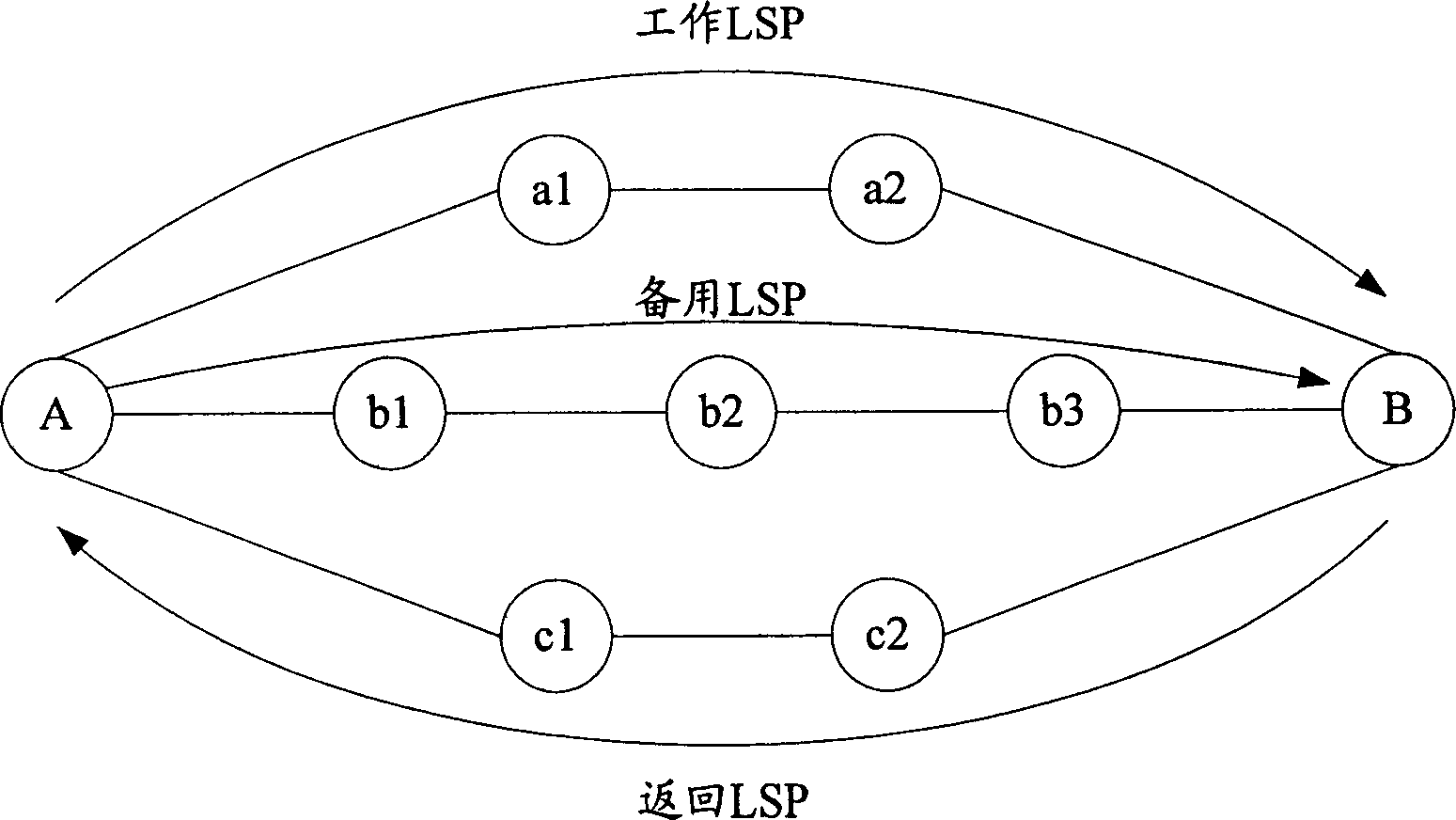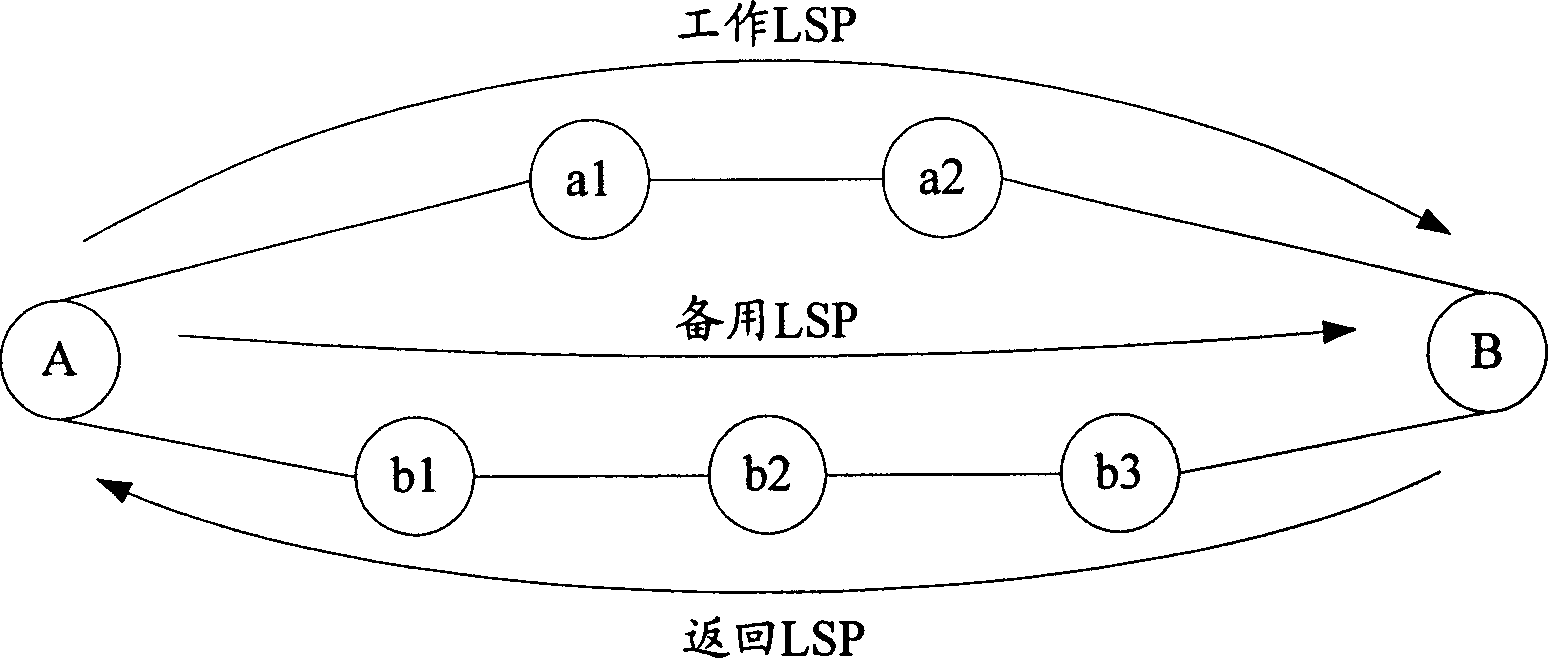Method for establishing return tag exchange route in multiprotocol tag exchange system
A label switching path, multi-protocol label technology, applied in transmission systems, electrical components, etc., can solve problems such as protection switching failure and fault information transmission
- Summary
- Abstract
- Description
- Claims
- Application Information
AI Technical Summary
Problems solved by technology
Method used
Image
Examples
Embodiment 1
[0035] The establishment method of returning LSP described in this embodiment includes the following steps:
[0036] Step 101: The source node sends an LSP establishment request with an explicit routing object to initiate establishment of a backup LSP, and each LSR in the backup LSP path establishes the backup LSP according to the path recorded in the explicit routing object.
[0037]According to the protocol, the source node in the MPLS network can establish an LSP by displaying the route. In this manner, the source node predetermines the path of the backup LSP, records the path in the explicit routing object of the LSP establishment request, and sends it to the next-hop LSR recorded in the explicit routing object. During the establishment of the backup LSP, each LSR establishes the forwarding path of the backup LSP according to the next-hop LSR recorded in the displayed routing object, and finally establishes the backup LSP according to the path recorded in the displayed rou...
Embodiment 2
[0043] The establishment method of returning LSP described in this embodiment includes the following steps:
[0044] Step 201: The source node sends an LSP establishment request with a recorded routing object to initiate the establishment of a backup LSP, and each LSR in the backup LSP path establishes a backup LSP according to a routing algorithm, and records the path of the backup LSP in the recorded routing object.
[0045] According to the protocol, the source node in the MPLS network can also initiate the establishment of a backup LSP in a hop-by-hop manner. In this way, each LSR in the LSP establishment process determines the next-hop LSR according to a certain routing algorithm. At this time, if the record routing object is carried in the LSP establishment request, each LSR in the establishment process will record its next-hop LSR, that is, the forwarding path in the record routing object. Therefore, when the backup LSP is established, that is, when the LSP establishme...
Embodiment 3
[0052] Step 301: the sink node sends an LSP establishment request with an explicit routing object to initiate establishment of a backup LSP, and each LSR on the backup LSP establishes the backup LSP according to the explicit routing object;
[0053] Step 302: After the backup LSP is established, the source node learns the path of the backup LSP in the MPLS network through the display route object in the LSP establishment message;
[0054] Step 303: The source node returns the display routing object in the LSP establishment request according to the reverse direction of the path of the backup LSP, that is, according to the sequence of all LSRs on the backup LSP path, arranges all LSRs in the reverse direction, and records them in the display routing object in sequence object, at this time, the path recorded in the display routing object is the reverse path of the backup LSP;
[0055] Step 304: The source node sends an LSP establishment request with the explicit routing object co...
PUM
 Login to View More
Login to View More Abstract
Description
Claims
Application Information
 Login to View More
Login to View More - R&D Engineer
- R&D Manager
- IP Professional
- Industry Leading Data Capabilities
- Powerful AI technology
- Patent DNA Extraction
Browse by: Latest US Patents, China's latest patents, Technical Efficacy Thesaurus, Application Domain, Technology Topic, Popular Technical Reports.
© 2024 PatSnap. All rights reserved.Legal|Privacy policy|Modern Slavery Act Transparency Statement|Sitemap|About US| Contact US: help@patsnap.com









